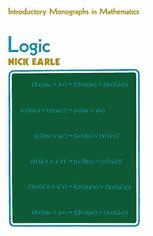Table Of ContentLOGIC
INTRODUCTORY MONOGRAPHS
IN MA THEMA TICS
General Editor
The late A. J. Moakes M.A.
Titles in the Series:
A Boolean Algebra A. B. Bowran
Abstract and Concrete
Matrices and their Applications J. R. Branfield and A. W. Bell
Programming by Case Studies O. B. Chedzoy and
Sandra E. Ford
Mathematics for Circuits W. Chellingsworth
Logic Nick Earle
Studies in Structure J. M. Holland
The Core of Mathematics A. J. Moakes
Numerical Mathematics A. J. Moakes
Exercises in computing with
a desk calculator
LOGIC
NICK EARLE
Headmaster, Bromsgrove School
MACMILLAN
Copyright © 1973 Nick Earle
All rights reserved. No part of this publication
may be reproduced or transmitted, in any form
or by any means, without permission
First published 1973
Published by
THE MACMILLAN PRESS LTD
London and Basingstoke
Associated companies in New York Toronto
Dublin Melbourne Johannesburg and Madras
ISBN 978-0-333-11344-8 ISBN 978-1-349-00935-0 (eBook)
DOI 10.1007/978-1-349-00935-0
The paperback edition of this book is sold subject to the condition
that it shall not, by way of trade or otherwise, be lent, resold, hired out,
or otherwise circulated without the publisher's prior consent in any
form of binding or cover other than that in which it is published and
without a similar condition including this condition being imposed on
the subsequent purchaser.
To C. W. L. and R. W. P. - for much forbearance
PREFACE
No originality is claimed for this work. It aims merely to sketch out, in
the briefest possible compass but with the greatest rigour consistent with
that compass, the logical foundations of mathematics as far as the
elementary properties of the natural numbers. Most text books of
mathematics take these properties as their starting pOint.1 It is the purpose
of mathematical logic to show that a more secure foundation is possible.
I have not attempted complete rigour. I have, for example, touched
only lightly on the question of logical types and the discerning reader
will recognise that this question is in fact of great importance. Indeed I
have not ventured far into the field of metalogic at all, believing that the
significance of the subject is inappropriate for the student for whom
the book is primarily intended, that is, someone to whom logic is a
wholly new discipline. Although this deficiency may give the book a
rather more 'classical' than 'modern' emphasis I contend that the con
cerns of modern logic are the better appreciated if the classical approach
is first understood. To appreciate Einstein it is helpful to have a firm
grasp of Newton. I hope that, despite these shortcomings, the argument
will be found satisfying so far as it goes.
It has long been my belief that the importance of Sixth Form
education - and perhaps of all formal education - lies not so much in
what is learnt as in the opportunities afforded to the student to explore
new topics with a view to discovering his own real interests. It is now
my hope that some students will be encouraged by this monograph
to find and develop interest in the further pursuit of what is perhaps the
most fascinating if the most elusive of all disciplines - mathematical
logic.
In conclusion, I should like to thank the following Institutions for
permission to reproduce in the book questions taken from past
examination papers:
University of Cambridge
University of Edinburgh
University of London, Schools Examinations Department
The British Computer Society.
Similar acknowledgement is also due to the publishers of:
Langer: Introduction to Symbolic Logic (Van Nostrand Reinhold
Company) and
Suppes: Introduction to Logic (Dover Publications Inc.,
New York, 1953, 1967; reprinted through permission of
the publishers)
CONTENTS
page
Preface
vii
1. The logic of propositions 1
2. The logic of sets 37
3. The logic of relations 77
4. The logic of arithmetic 105
Appendix: The logic of the syllogism 127
Suggestions for further reading 136
Index 137
THE LOGIC OF PROPOSITIONS
1.1 Demonstration and proof: the law of gravity
The following extract is taken from Galileo's Dialogue concerning Two
New Sciences. It deals with the question of whether or not bodies of
unequal mass fall with unequal speeds. Galileo's own demonstration
that in fact they do not is often taken as the starting point for a history
of modern science. It may appropriately serve to introduce a discussion
of the part which logic has had to play in science. The dialogue takes
place between three people - Simplicio, Sagredo and Salvator.
SIMPLICIO: Aristotle's language would seem to indicate that he had
tried the experiment (of allOWing unequal masses to fall
through equal distances) because he says 'We see the
heavier (fall faster than the lighter)'; now the word see
shows that he had made the experiment.
SAG REDO: But I, Simplicio, who have made the test, can assure you
that a cannon-ball weighing one or two hundred pounds
or even more will not reach the ground by as much as a
span ahead of a musket-ball weighing only half a pound,
provided both are dropped from a height of one hundred
cubits.
SALV ATOR: But even without further experiment is is possible to
prove clearly by means of a short and conclusive argument
that a heavier body does not move more rapidly than a
lighter one, provided both bodies are of the same material
and in short such as those mentioned by Aristotle. But
tell me, Simplicia, whether you admit that each falling
body acquires a definite speed fixed by nature, a velocity
which cannot be increased or diminished except by the
use of force or resistance.
SIMPLICIO: There can be no doubt that one and the same body,
moving in a single medium, has a fixed velocity which is
determined by nature and which cannot be increased

